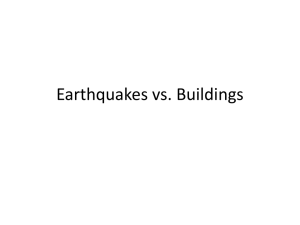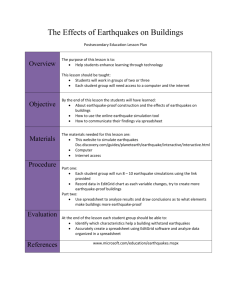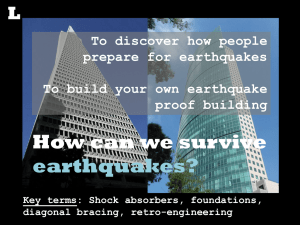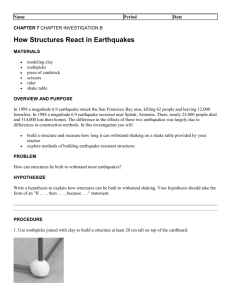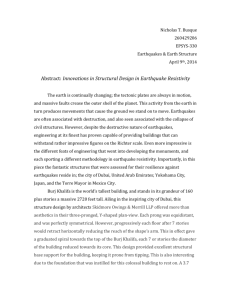Earthquake Simulation
advertisement
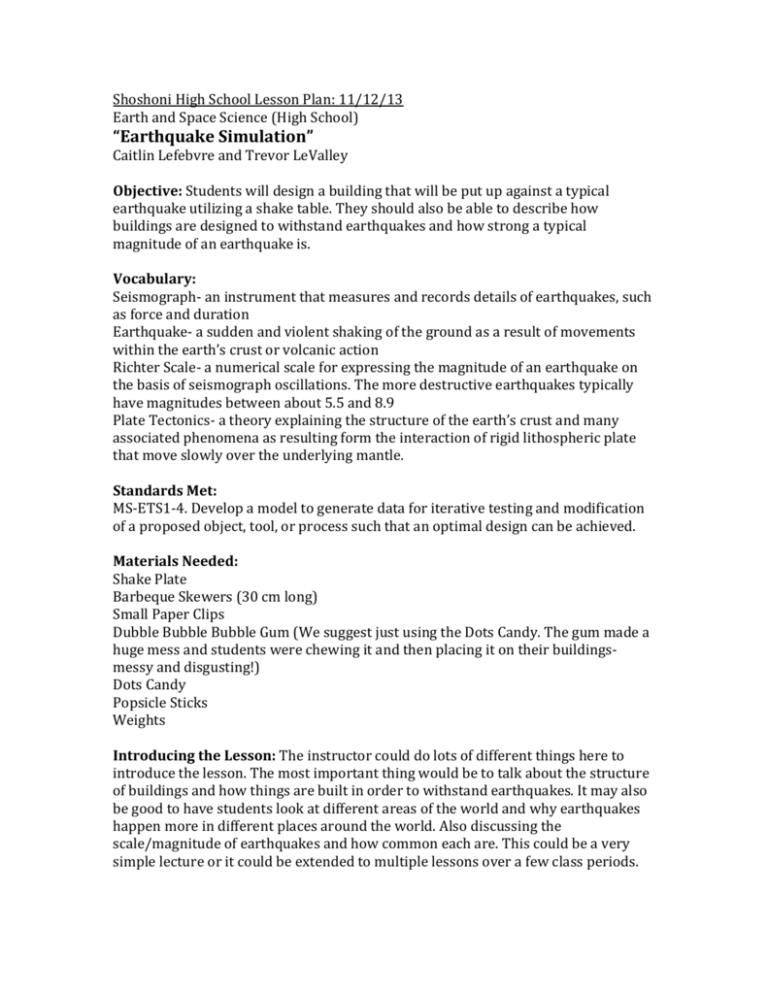
Shoshoni High School Lesson Plan: 11/12/13 Earth and Space Science (High School) “Earthquake Simulation” Caitlin Lefebvre and Trevor LeValley Objective: Students will design a building that will be put up against a typical earthquake utilizing a shake table. They should also be able to describe how buildings are designed to withstand earthquakes and how strong a typical magnitude of an earthquake is. Vocabulary: Seismograph- an instrument that measures and records details of earthquakes, such as force and duration Earthquake- a sudden and violent shaking of the ground as a result of movements within the earth’s crust or volcanic action Richter Scale- a numerical scale for expressing the magnitude of an earthquake on the basis of seismograph oscillations. The more destructive earthquakes typically have magnitudes between about 5.5 and 8.9 Plate Tectonics- a theory explaining the structure of the earth’s crust and many associated phenomena as resulting form the interaction of rigid lithospheric plate that move slowly over the underlying mantle. Standards Met: MS-ETS1-4. Develop a model to generate data for iterative testing and modification of a proposed object, tool, or process such that an optimal design can be achieved. Materials Needed: Shake Plate Barbeque Skewers (30 cm long) Small Paper Clips Dubble Bubble Bubble Gum (We suggest just using the Dots Candy. The gum made a huge mess and students were chewing it and then placing it on their buildingsmessy and disgusting!) Dots Candy Popsicle Sticks Weights Introducing the Lesson: The instructor could do lots of different things here to introduce the lesson. The most important thing would be to talk about the structure of buildings and how things are built in order to withstand earthquakes. It may also be good to have students look at different areas of the world and why earthquakes happen more in different places around the world. Also discussing the scale/magnitude of earthquakes and how common each are. This could be a very simple lecture or it could be extended to multiple lessons over a few class periods. Engage: The students will begin to build their structures to be tested on the shake table. If teachers do not have the ability to use a shake table a pan of Jello that the structure can be stuck in and wiggled. The teacher can give the students as little time or a period over a weekend to build their structures. Encouraging the students to compete would be good here and it would allow for some healthy competition among the students. Whoever wins could have the change for a box of candy or even some extra credit. Further Investigation: Students could have the opportunity to complete a grant proposal prior to building. This would show the amount of effort put in on researching their design. They also could complete additional money requests (a short paper/explanation) if they run out of supplies during construction. Questions That Students Should Be Able To Answer: 1. What causes an earthquake? 2. What are plate tectonics? 3. How are buildings designed in order to withstand earthquakes? 4. What scale is used to measure the intensity of the earthquakes? 5. What is aftershock? Procedure: Have students begin by researching the strength of structures. Students are given a set amount of time to build their structure (anywhere from a class period or a weekend) Allow students to test their buildings on the shake table Continue to increase the magnitude of the mini earthquake until only 1 group (or a few) remains. Have fun! After presenting the lesson and going through the experiment we have a few tips on the buildings: 1. Allowing the students a day to plan their buildings before they obtain the supplies helps for stronger buildings. The students did research and you could tell who put a lot of time into the investigation before the construction. 2. Place a tablecloth or trash bag down on the table before construction. The designs got really messy and it would have been a little easier with a prepared clean up. 3. When we began testing the buildings we had to modify how the students were going to test. A majority of the buildings were designed to hold any way so we ended up giving the students an amount of time that the buildings had to survive.
